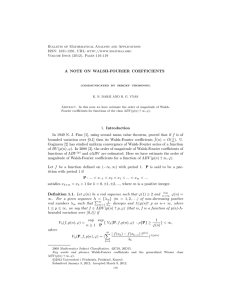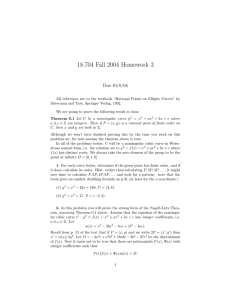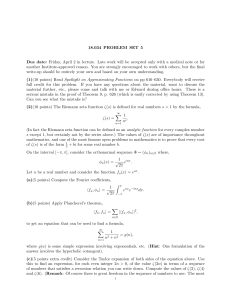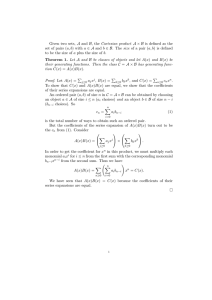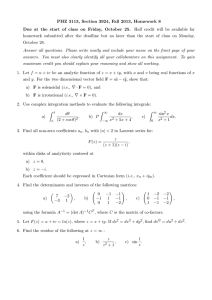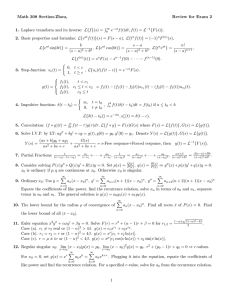THE BEKER–D ¨ ORING SYSTEM AND ITS LIFSHITZ–SLYOZOV LIMIT
advertisement
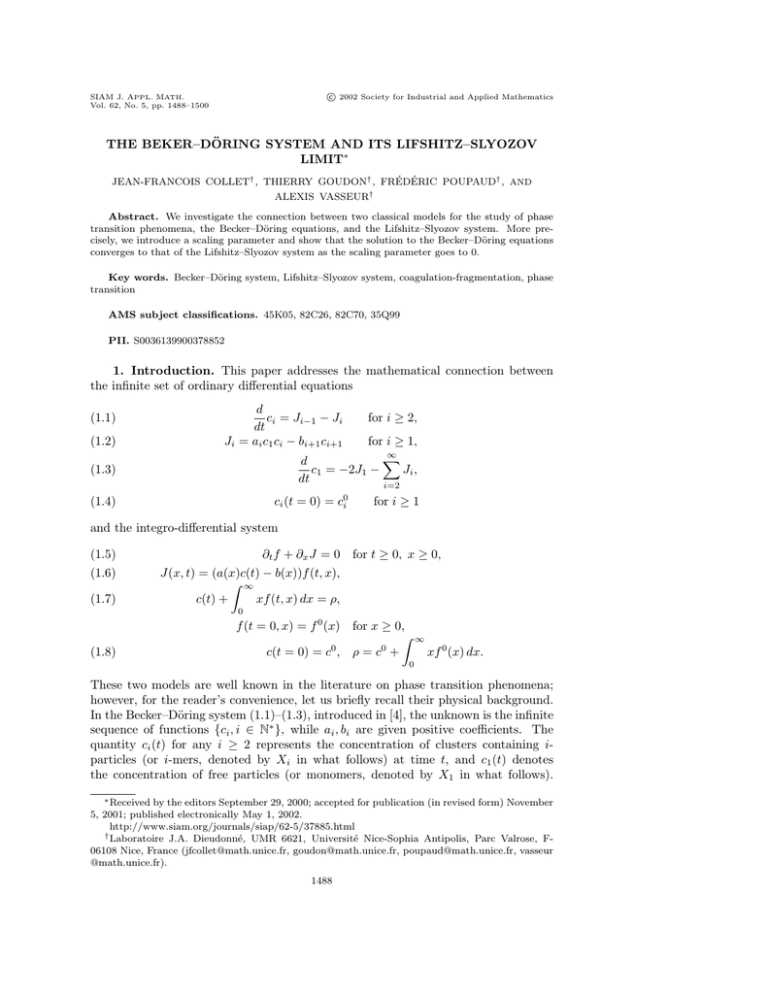
c 2002 Society for Industrial and Applied Mathematics
SIAM J. APPL. MATH.
Vol. 62, No. 5, pp. 1488–1500
THE BEKER–DÖRING SYSTEM AND ITS LIFSHITZ–SLYOZOV
LIMIT∗
JEAN-FRANCOIS COLLET† , THIERRY GOUDON† , FRÉDÉRIC POUPAUD† , AND
ALEXIS VASSEUR†
Abstract. We investigate the connection between two classical models for the study of phase
transition phenomena, the Becker–Döring equations, and the Lifshitz–Slyozov system. More precisely, we introduce a scaling parameter and show that the solution to the Becker–Döring equations
converges to that of the Lifshitz–Slyozov system as the scaling parameter goes to 0.
Key words. Becker–Döring system, Lifshitz–Slyozov system, coagulation-fragmentation, phase
transition
AMS subject classifications. 45K05, 82C26, 82C70, 35Q99
PII. S0036139900378852
1. Introduction. This paper addresses the mathematical connection between
the infinite set of ordinary differential equations
(1.1)
(1.2)
d
ci = Ji−1 − Ji
dt
Ji = ai c1 ci − bi+1 ci+1
for i ≥ 2,
for i ≥ 1,
∞
d
c1 = −2J1 −
Ji ,
dt
i=2
(1.3)
ci (t = 0) = c0i
(1.4)
for i ≥ 1
and the integro-differential system
(1.5)
(1.6)
(1.7)
(1.8)
∂t f + ∂x J = 0 for t ≥ 0, x ≥ 0,
J(x, t) = (a(x)c(t) − b(x))f (t, x),
∞
c(t) +
xf (t, x) dx = ρ,
0
f (t = 0, x) = f 0 (x) for x ≥ 0,
c(t = 0) = c0 , ρ = c0 +
0
∞
xf 0 (x) dx.
These two models are well known in the literature on phase transition phenomena;
however, for the reader’s convenience, let us briefly recall their physical background.
In the Becker–Döring system (1.1)–(1.3), introduced in [4], the unknown is the infinite
sequence of functions {ci , i ∈ N∗ }, while ai , bi are given positive coefficients. The
quantity ci (t) for any i ≥ 2 represents the concentration of clusters containing iparticles (or i-mers, denoted by Xi in what follows) at time t, and c1 (t) denotes
the concentration of free particles (or monomers, denoted by X1 in what follows).
∗ Received
by the editors September 29, 2000; accepted for publication (in revised form) November
5, 2001; published electronically May 1, 2002.
http://www.siam.org/journals/siap/62-5/37885.html
† Laboratoire J.A. Dieudonné, UMR 6621, Université Nice-Sophia Antipolis, Parc Valrose, F06108 Nice, France (jfcollet@math.unice.fr, goudon@math.unice.fr, poupaud@math.unice.fr, vasseur
@math.unice.fr).
1488
FROM BECKER–DÖRING TO LIFSHITZ–SLYOZOV
1489
Intuitively, ci may be thought of as the number of i-mers present in the solution.
More precisely, if one used a finite-mass description of the system, denoting by ni the
total number of i-mers, then ci (t) would be the expected value of this random variable
at time t. Equation (1.1) is the kinetic equation for the ci ’s. It expresses the net rate
of change of ci due to the reactions
Xi + X1 Xi+1 ,
by which i-mers can gain (coagulation) monomers to become i+1-mers or, conversely,
(fragmentation). The quantity Ji denotes the rate of this reaction. Its expression in
terms of the concentrations is obtained from a straightforward application of massaction kinetics, denoting by ai and bi+1 the coagulation and fragmentation rates.
Equation (1.3) expresses the net rate of change of c1 . (Note that monomers are
involved in infinitely many reactions.) It can be shown (see [1]) to imply the following
relation:
m1
∞
ici (t) = ρ,
i=1
which means conservation of the total amount of monomers present in the solution.
Here m1 denotes the mass of one monomer. The system is supplemented by the
Cauchy data (1.4).
In the Lifshitz–Slyozov model (1.5)–(1.7), on the other hand, the size of clusters
is thought of as a continuously varying variable x > 0, which will now replace i.
The quantity f (t, x) designates the density of aggregates with respect to this size
variable, and c(t) denotes the concentration of monomers. Equation (1.5) is the
continuity equation in size space, whereas the third equation again represents the
conservation of monomers. To obtain a precise expression of the flux J, one needs
to derive an expression for the growth rate of grains, and this in turn requires a
physical description of the interaction between clusters and monomers. By making
assumptions on this mass-transfer mechanism (e.g., assuming it to be diffusion-limited,
or surface-attached, or other), one may then obtain an explicit expression for the
rate coefficients a and b. Details can be found in the original paper [14] or in the
recent review [20]. Here we will restrict ourselves only to a more phenomenological
level, in which the details of the cluster/monomer interaction are subsumed into the
(God-given) coefficients ai , bi for the discrete case, or a(x), b(x) for the continuous
case. Since these two models are obtained from rather different approaches, it seems
interesting to investigate how one may be obtained from another. Since the Lifshitz–
Slyozov model treats size as a continuous variable, it seems that it should be obtainable
from the Becker–Döring one as either a “macroscopic” or “large time” limit. More
precisely, since these models describe a later stage of coarsening, in which the average
cluster size increases monotonically with time, it is physically reasonable that the
large time dynamics of the Becker–Döring system should in a sense be close to that
of the Lifshitz–Slyozov system. A precise mathematical formulation of this idea may
be found in [19]. Here we will take a “macroscopic limit” point of view, much in the
spirit (although the mathematical structure is simpler here) of hydrodynamic limits
in fluid mechanics; see [10]. The mathematical theory of both systems is by now fairly
complete. An extensive study of the Becker–Döring system for nonnegative initial data
with finite total mass ρ may be found in [1]. In particular, the existence of solutions
is proved for coefficients ai , bi = O(i) (see Theorem 2.2 of [1]), whereas existence fails
if the coefficients grow faster than i. Uniqueness is obtained under supplementary
1490
COLLET, GOUDON, POUPAUD, AND VASSEUR
assumptions on higher moments of the initial data, and a thorough description of the
asymptotic behavior is given. Here we will place ourselves in situations where the
existence and uniqueness results of [1] apply.
The well-posedness theory for the Lifshitz–Slyozov equations is discussed in [5] for
smooth coefficients and in [12] for more general ones. Global existence and uniqueness is also discussed in [17]. The papers [16], [18] have very complete results on
the asymptotic behavior, and [15] has a derivation of (1.5)–(1.7) via homogenization
methods. A variant of this system in which encounters between clusters are taken
into account is studied in [6] and [13].
The outline of the paper is as follows. In section 2, we introduce the relevant
nondimensional numbers and rewrite the system (1.1)–(1.3) in dimensionless form.
Sections 3 and 4 are devoted to the hyperbolic and parabolic scalings, respectively.
2. Notation and dimensionless equations. For a fixed value of the rescaling
parameter , we will use the results in [1] to obtain a uniquely defined solution (the
precise definition of which may be found in [1]) to the rescaled problem as well as
some estimates on its moments. More precisely, we will make use of the following
results (see, respectively, Theorems 3.7 and 2.5 in [1]).
2.1 (see [1]). Assume that the initial data is nonnegative
and satisfies
√
∞Theorem
0
ic
<
∞.
Assume
that
the
coefficients
satisfy
a
,
b
=
O(
i).
Then
the problem
i i
i=1 i
(1.1)–(1.4) admits one and only one solution.
Theorem 2.2 (see [1]). Let c be a solution to (1.1)–(1.3), and let ϕi be a nonnegative sequence satisfying the following assumptions:
∞
∞
t2
|ϕi+1 − ϕi |ai ci (t) dt < ∞, sup
ϕi ci (t) < ∞,
(2.1)
t
t1 i=1
i=1
ϕi+1 − ϕi ≥ 0 for i large enough.
Then for any m ≥ 2 the following relation holds true:
t2 ∞
∞
ci (t2 )ϕi +
bi+1 ci+1 (s)(ϕi+1 − ϕi ) ds
t1
i=m
i=m
t2 ∞
∞
(2.2)
ci (t1 )ϕi +
ai c1 (s)ci (s)(ϕi+1 − ϕi ) ds
=
t1
i=m
i=m
t2
+
ϕm (am−1 c1 (s)cm−1 (s) − bm cm (s)) ds.
t1
In the case where the kinetic coefficients are bounded, it follows from Theorem
2.2 in [1] that assumption (2.1) is satisfied for ϕi = 1, and ϕi = iα for any α ≥ 1.
This will make it possible to derive estimates on the moments of the solution. We
will also use (2.2) with sequences having only finitely many nonzero terms.
Before rescaling the system (1.1)–(1.3) in terms of a small parameter, we first
rewrite it in dimensionless form. Let us summarize all of the absolute constants and
reference quantities which will be used in what follows:
• T : characteristic time,
• C1 : characteristic value for the monomer concentration c1 ,
• C: characteristic value for the large cluster concentration ci , i ≥ 2,
• A1 : characteristic value for the first coagulation coefficient a1 ,
• A: characteristic value for the coagulation coefficients ai , i ≥ 2,
• B: characteristic value for the fragmentation coefficients bi , i ≥ 2,
1491
FROM BECKER–DÖRING TO LIFSHITZ–SLYOZOV
• M : characteristic value for the total mass,
• m1 : mass of one monomer,
• N : Avogadro number,
• Mm : molar mass of monomers: Mm = N m1 .
Note that due to the particular role played by monomers we will have A1 = A,
which means that the kinetic equation for c2 , which involves the quantity c21 , will be
rescaled in a different way from the generic ith equation.
The corresponding dimensionless quantities are then defined as
(2.3)
(2.4)
t=
t
,
T
c1 (t) = c1 (tT )/C1 ,
ci (t) = ci (tT )/C,
ai =
a1 =
ai
,
A
a1
,
A1
bi =
ρ=
ρ
,
M
bi
for i ≥ 2.
B
When one rewrites (1.1)–(1.3) in terms of the new variables, the following dimensionless parameters appear:
MN
M
γ = C/C1 ,
µ=
=
,
Mm C1
m1 C1
(2.5)
α = AT C1 ,
α1 = A1 C1 /AC,
β = BT.
Omitting the overlines, the system takes the following dimensionless form:
(2.6)
(2.7)
(2.8)
d
ci = α(ai−1 c1 ci−1 − ai c1 ci ) + β(bi+1 ci+1 − bi ci )
for i > 2,
dt
d
c2 = α1 α a1 c21 − αa2 c1 c2 + β(b3 c3 − b2 c2 ),
dt
∞
dc1
= −γ 2(α1 α a1 c21 − β b2 c2 ) +
(α ai c1 ci − β bi+1 ci+1 ) .
dt
i=2
As we noted above, by taking ϕ = i in (2.2), we obtain mass conservation:
(2.9)
c1 + γ
∞
ici = µρ.
i=2
The dimensionless parameters defined in (2.5) appear as coefficients in this problem
and need to be scaled appropriately with respect to . Let us begin by explaining the
heuristics of this choice. If the right-hand side in (2.6) is to yield a derivative, then
α and β should scale as the reciprocal of . The quantity expressed in (2.9) is the
total mass of the system. If this is to remain finite (and nonzero), then µ should be
of order 1. We would then like to view the sum over i in this equation as a Riemann
sum for the integral in (1.7). Observing the system on a larger scale means taking
x = i; thus γ should be taken of the same order as x dx, that is, the square of .
More precisely, we are interested in the asymptotic behavior of large clusters
whose size is on the order of 1/. For instance, if i-particles are spheres with radius
Lri , where L is a characteristic length and ri is dimensionless, we have the relation
3Vm 1/3 1/3
) i , which involves the molar volume of free atoms Vm . Hence we
Lri = ( 4πN
3
N
consider a situation in which 1/ = 4πL
3Vm is large. The total mass of the aggregates
∞
(excluding monomers) is equal to m1 C i=2 ic̄i . Assuming that the average size is
on the order of 1/ and that all c̄i ’s are of order 1, we see that the total mass is on
1492
COLLET, GOUDON, POUPAUD, AND VASSEUR
the order of C m1 /2 . For that mass to be on the same order as the total mass of
free monomers m1 C1 , as well as the total mass, we therefore need to take γ = 2 and
µ = 1 (C = 2 C1 , C1 = M/m1 ). In the same way, we assume that for large clusters
the fragmentation is of the same order as coagulation, and M is chosen accordingly:
AC1 = B (M = Bm1 /A and α = β). Clearly, if one phenomenon dominates the
other, then in the continuous limit → 0 one term vanishes, thus making the limiting
regime either purely a coagulation regime or a fragmentation regime. In order to
obtain nontrivial dynamics, it remains to fix the time scale with T = 1/(B), which
means we study the large time behavior of the system.
These heuristic remarks naturally lead us to the following choice of the parameters
in terms of :
γ = 2 ,
µ = 1,
α = β = 1/,
α1 ≤ 1.
At this point, a word of explanation about the bound imposed on α1 is in order.
This bound roughly says that, as the observational scale increases, the first reaction
(encounter of two monomers to form a dimer) plays a negligible role. From the
mathematical point of view, this means that we get rid of the negative power of which this reaction introduces; from the physical point of view, it means that, in
the macroscopic limit, we eliminate the coupling between (macroscopic) clusters and
(microscopic) monomers introduced by this reaction. This was remarked upon in [7]
and is reminiscent of the so-called infrared difficulty encountered when going from a
granular to a continuous description of matter.
With this choice of the parameters, the rescaled version of (2.6)–(2.8) is
d
1
1
ci = (ai−1 ci−1 − ai ci )c1 + (bi+1 ci+1 − bi ci ) for i > 2,
dt
d
1
1
1
c2 = α1 a1 c21 − a2 c1 c2 + (b3 c3 − b2 c2 ),
dt
∞
d
2
c
=
−2(a
α
c
−
b
c
)
−
(ai ci c1 − bi+1 ci+1 ).
1
1 1 1
2 2
dt
i=2
This rescaled system is the starting point of our analysis. Throughout the remainder of the paper, we will denote by (c
i )i≥1 the solution to that system. The summation
by parts formula corresponding to (2.2) is now (taking m = 2, t1 = 0, t2 = t)
t ∞
∞
bi+1 ci (t)ϕi +
c (s)(ϕi+1 − ϕi ) ds
i+1
0
i=2
i=2
t
∞
∞
ai (2.10)
c (s)ci (s)(ϕi+1 − ϕi ) ds
ci (0)ϕi +
=
1
0
i=2
i=2
t α1
b2
+
ϕ2 a1 (c
1 (s))2 − c
2 (s) ds.
0
As mentioned above, in the case of bounded coefficients ai , this formula holds true for
ϕi = 1 and ϕi = iα (α ≥ 1). The choice ϕi = 1 gives an estimate on the total number
of clusters, whereas the choice ϕi = i yields mass conservation.
We will denote by f the function defined by
f (t, x) = c
i (t)
if t > 0, xi = i ≤ x < xi+1 = (i + 1) for some
i ≥ 2,
FROM BECKER–DÖRING TO LIFSHITZ–SLYOZOV
1493
and f (t, x) = 0 if x ∈ [0, 2[. This choice of a piecewise constant function, with
“mesh size” , is convenient because sums such as the one in (2.9) will be handled as
Riemann sums
and
will converge to the corresponding integral once it is known that
the sequence f >0 has a limit.
Our main result then shows that for close to zero, the couple (c
1 , f ) is an
approximate solution to the Lifshitz–Slyozov system.
Theorem 2.3. Assume the kinetic coefficients ai , bi satisfy
(2.11)
ai , bi ≤ K,
|ai+1 − ai | ≤ K/i,
|bi+1 − bi | ≤ K/i
for some constant K. Consider a sequence n → 0.
Then there exist a subsequence, which we will still denote by n , and two functions
1,∞
a, b ∈ Wloc
((0, ∞)) ∩ L∞ ((0, ∞)) such that, for any R > r > 0,
|ai − a(n i)| + |bi − b(n i)| = 0.
(2.12)
sup
lim
n →0 i∈(r/
,R/
)
n
n
Assume, moreover, that there exist four constants 0 < s ≤ 1, M0 < ∞, ρ < ∞, Ms <
∞ for which, for all > 0,
(2.13) ∞
i=2
c0,
i ≤ M0 ,
2
c0,
1 +
∞
i=2
ic0,
i = ρ,
∞
i=2
(i)1+s c0,
i ≤ Ms .
Then the subsequence n may be chosen in such a way that
f n & f, xf n & xf in C 0 ([0, T ]; M1 (0, ∞) − weak − ∗),
c
1n (t) → c(t) uniformly in C 0 ([0, T ]),
where (c, f ) is a solution to (1.5)–(1.8).
Remark 2.4. In our scaling approach, it is obvious that the coefficients ai , bi
should not depend on . Thus, for the continuous limits a, b to be locally bounded and
Lipschitz (a very natural condition) and for convergence (2.12) to hold true, it appears
that the boundedness condition (2.11) is in fact necessary. This means that condition
(2.11) is optimal. Another approach, more numerical-analytic than modelling in spirit,
could be to a priori fix the coefficients a and b and to introduce an -dependence for the
discrete coefficients in order to impose a convergence. In this case, condition (2.11)
may be relaxed in order to allow growth of the coefficients for large sizes.
Remark 2.5. Here M1 (0, ∞) denotes the space of bounded measures on (0, ∞),
that is, the dual of the space C00 ((0, ∞)) of continuous functions vanishing at infinity
and for x = 0; see [8]. The map f in this context is a measure-valued solution to the
Lifshitz–Slyozov equation (see [5] for a precise definition) so that, for any time t, we
have f (t, ·) ∈ M1 (0, ∞).
Remark 2.6. By condition (2.13), the initial data has to be prepared with respect
to . The condition on the zeroth moment means that the ratio of the initial number
of agglomerates over C1 is of order since we have
C/C1
∞
i=2
2
c0,
i =
∞
i=2
c0,
i =
Initial number of agglomerates
.
C1
Remark 2.7. This theorem gives useful information only when the system (1.5)–
(1.8) is well-posed. This requires the characteristics of the transport equation (1.5)–
(1.6) to point in the negative direction at x = 0 (together with some regularity assumptions on the coefficients a and b; we refer for detailed results to [5], [12]). This
1494
COLLET, GOUDON, POUPAUD, AND VASSEUR
condition reads a(0)c(t) − b(0) ≤ 0, which, for instance, follows from the stronger condition ρ ≤ b(0)/a(0). In this case, the uniqueness of the limit implies that the whole
sequence converges in Theorem 2.3, provided (2.12) holds true. However, when this
condition is not fulfilled, the system (1.5)–(1.8) has to be supplemented by a boundary
condition at x = 0. We have not addressed this issue here, and finding the appropriate
boundary condition is an open problem even from the physical point of view. A partial
answer is given in section 4, in which we obtain a viscous correction to (1.5)–(1.8),
together with a Dirichlet boundary condition, by making use of formal asymptotics.
By extrapolating the result of [2] for scalar conservation laws (see also [3]), one might
therefore conjecture that, in the case where c(t) ≥ b(0)/a(0), the correct boundary
condition for (1.5)–(1.8) would be
(a(0)c(t) + b(0)) f (t, 0) = 2a1 c(t)2 .
3. From Becker–Döring to Lifshitz–Slyozov. Our theorem is merely a compactness statement about the sequence (c
1 , f ). The compactness for f is obtained
by showing boundedness of a higher moment, whereas the compactness for c
1 is obtained by the use of the Arzelà–Ascoli theorem, in the spirit of [5]. These properties
form the content of the next two lemmas.
Lemma 3.1. Assume that the kinetic coefficients verify (2.11) and that the initial
data satisfy (2.13). Then for any T > 0 there exists a constant C < ∞ which depends
only on s, M0 , Ms , ρ, K, and T , such that, for any > 0,
∞
sup
(1 + x + x1+s )f (t, x) dx ≤ C.
t∈[0,T ]
0
Proof. The letter C will denote any constant depending on the data, as indicated
in the statement of the result. Choosing ϕi = in (2.10), we obtain
∞
t
∞
∞
f (t, x) dx = c
i (t) = c0,
+
[α1 a1 (c
1 (τ ))2 − b2 c
2 (τ )] dτ
i
0
i=2
i=2
0
2
≤ M0 + α1 ρ T.
The estimate on the first moment may be derived similarly and is in fact derived in
[1]; see (2.9). To deal with the higher moment, as a technical device we introduce the
function e
defined by
e
(x) = xi
if xi = i ≤ x < xi+1 = (i + 1) for some
i ≥ 2,
and e
(x) = 0 if x ∈ [0, 2[. We observe that for any positive r we have
∞
∞
∞
∞
(x/2)r f (t, x) dx ≤
(e
(x))r f (t, x) dx = (i)r c
i (t) ≤
xr f (t, x) dx.
0
0
0
i=2
We now take ϕi = [e
(i)]1+s = [i]1+s in (2.10) to obtain
∞
∞
[e
(x)]1+s f (t, x) dx = (i)1+s c
i (t)
0
i=2
=
∞
i=2
(i)1+s c0,
i −
t
∞
0 i=2
((i + )1+s − (i)1+s )
FROM BECKER–DÖRING TO LIFSHITZ–SLYOZOV
1495
· bi+1 c
i+1 (τ ) dτ
t
∞
+
((i + )1+s − (i)1+s ) ai c
i (τ )c
1 (τ ) dτ
0 i=2
t
+
0
(2)1+s (α1 a1 (c
1 (τ ))2 − b2 c
2 (τ )) dτ.
In the right-hand side of this equality, the first term is less than Ms , and the fragmentation term has a negative contribution. (Fragmentation acts as a dissipation
mechanism for moments of order larger than 1.) Using the fact that < 1 and s ≤ 1,
it is very easy to check that, for any i, we have
(i + )1+s − (i)1+s ≤ (1 + s)(1 + i).
We may therefore estimate the coagulation term as follows:
t
∞
0 i=2
((i + )1+s − (i)1+s ) ai c
i (τ )c
1 (τ ) dτ
t
∞
c
i (τ )(1 + s)(1 + i) dτ
0 i=2
t ∞
= Kρ (1 + s)
(1 + e
(x))f (τ, x) dx dτ
0
0 t
∞
≤ Kρ (1 + s)
(1 + x)f (τ, x) dx dτ ≤ C,
≤ Kρ
0
0
and this completes the proof of the lemma.
Lemma 3.2. Assume that the kinetic coefficients verify (2.11) and that the initial
data
satisfy (2.13). Then, for any T > 0, the sequence of monomers concentrations
c1 >0 is equicontinuous on [0, T ].
Proof. By using mass conservation and formula (2.10), we can write
c
1 (t + h) − c
1 (t)
=
−2
ic
i (t + h) + 2
i=2
∞
t+h = ∞
t
i=2
t+h
∞
ic
i (t)
i=2
bi+1 c
i+1 (τ )dτ
2
2(α1 a1 (c
1 (τ ))
−
t
∞
t+h ai c
i (τ )c
1 (τ ) dτ
i=2
b2 c
2 (τ )) dτ
−
−
tt+h ∞
= −
(a
(x)c
1 (τ ) − b
(x))f (τ, x) dx dτ
t
0
t+h
2
−
(2α1 a1 (c
1 (τ )) − b2 c
2 (τ )) dτ,
t
where a , b are the piecewise constant functions defined from the ai , bi ’s in the same
way as f was defined from the c
i ’s. On one hand, the space integral satisfies
t+h ∞
t+h ∞
(a (x)c1 (τ ) − b (x))f (τ, x) dx dτ ≤ K(1 + ρ)
f (τ, x) dx dτ
t
0
t
0
≤ C(T )h
1496
COLLET, GOUDON, POUPAUD, AND VASSEUR
by using Lemma 3.1. On the other hand, the boundary terms are estimated as follows:
t+h
0≤
2α1 a1 (c
1 (τ ))2 dτ ≤ 2Kρ2 h,
t
and
0≤
t+h
t
b2 f (τ, 2) dτ
≤ K
t
≤ K
t+h
t+h
t
∞
i=2
∞
0
f (τ, i) dτ
f (τ, x) dx dτ ≤ C(T )h,
again by using the estimate of Lemma 3.1. Therefore, we conclude that |c
1 (t + h) −
c
1 (t)| tends to 0 as h goes to 0, uniformly with respect to > 0 and t ∈ [0, T ].
Proof of Theorem 2.3. By the Arzelà–Ascoli theorem and Lemma 3.2, we can
suppose that
c
1 (t) → c(t) uniformly in C 0 ([0, T ]).
Let ϕ be a smooth test function supported in [δ, R] for some 0 < δ < R < ∞. We set
ϕ
(x) = ϕ(i)
for i ≤ x < (i + 1).
Since, for x > 0, we have
|ϕ(x) − ϕ
(x)| ≤ ϕ L∞ ,
ϕ
converges uniformly to ϕ on [0, ∞[. We now use (2.10) with ϕi = ϕ(i). For
< δ/2, the boundary term in (2.10) disappears by using the support property of ϕ.
Therefore, we obtain
∞
∞
f (t, x)ϕ (x) dx −
f (0, x)ϕ
(x) dx
0
0
(3.1)
t
∞
f (τ, x)(a
(x)c
1 (τ )∆+ ϕ
(x) + b
(x)∆− ϕ
(x)) dx dτ,
=
0
0
where we have set
∆± ϕ
(x) =
ϕ
(x ± ) − ϕ
(x)
.
It is straightforward to check that, as → 0, the quantity ∆± ϕ
converges to ±ϕ
uniformly on [0, ∞[.
∞Note that (3.1) and the estimates of Lemma 3.1 also prove that the sequence
( 0 f (t, x)ϕ
(x) dx)
>0 is equicontinuous on [0, T ] and equibounded. Therefore, by
the Arzelà–Ascoli theorem, it belongs to a compact set of C 0 ([0, T ]). Moreover, since
∞
ϕ
approaches ϕ uniformly on R+ , one deduces that ( 0 f (t, x)ϕ(x) dx)
>0 lies in a
compact set of C 0 ([0, T ]). By density, we realize that this also holds true in the case
when ϕ ∈ C00 ((0, ∞)). Now, by using the separability of C00 ((0, ∞)) and the Cantor
diagonal process, we obtain for a subsequence (still denoted by for simplicity) the
following convergence for any ϕ ∈ C00 ((0, ∞)) and any T > 0:
∞
∞
ϕ f (t, x) dx →
ϕ f (t, dx)
0
0
FROM BECKER–DÖRING TO LIFSHITZ–SLYOZOV
1497
as goes to 0, uniformly on [0, T ] for some f ∈ C 0 ([0, ∞); M1 (0, ∞) − weak − ∗). By
virtue of the estimates of Lemma 3.1, we also know that
(1 + |x|s )f ∈ L∞ ([0, ∞); M1 (0, ∞)).
Therefore, we obtain the convergence results stated in the theorem. In particular, at
t = 0, the limit f (t = 0, x) is given by the limit of f n (0, x) constructed from the
n
’s.
c0,
i
Now we are able to pass to the limit in (3.1). The hypotheses on the kinetic
coefficients ensure that, at least for a subsequence, a
and b
converge uniformly on
any compact set [δ, M ] to some continuous functions a(x), b(x). Let us postpone to
the appendix the proof of this claim. Then, by using the compactness result of Lemma
3.2, we get
∞
∞
ϕ(x) f (t, dx) =
ϕ(x) f (0, dx)
0
0 t
∞
+
(a(x)c1 (τ ) − b(x))ϕ (x) f (τ, dx) dτ,
0
0
which corresponds to the transport equation (1.5). It remains to show that the conservation relation also passes to the limit. However, this follows easily from the uniform
convergence e
(x) → x and the extra-moment estimate in Lemma 3.1 with s > 0; we
thus have
∞
∞
e (x)f (t, x) dx = ρ = c(t) +
x f (t, dx).
lim c1 (t) +
→0
0
0
∞
Note that we are not able to determine the limit of 0 f (t, x) dx because of the
possible concentration of f as a Dirac mass at x = 0. We conclude that (c, f ) is a
solution to (1.5)–(1.7), and this completes the proof of the theorem.
4. Second-order expansion: The modified Lifshitz–Slyozov model. The
connection between the discrete model (1.1)–(1.3) and the continuous one as the
reference size becomes large may also give some insight into a physically relevant
boundary condition for the Fokker–Planck-like equation presented in [9], [11]. For the
sake of simplicity, let us take α1 = 1. Then (2.10) may be rewritten as follows:
∞
∞
c
i (t2 )ϕi −
c
i (t1 )ϕi
i=2
i=2
t2 ∞
∞
ϕi+1 − ϕi−1 ϕi+1 − 2ϕi + ϕi−1
+
dτ
ai c1 (τ )ci (τ )
ai c1 (τ )ci (τ )
=
2
2
t1
i=2
i=2
t2
∞
∞
ϕi+1 − ϕi−1 ϕi+1 − 2ϕi + ϕi−1
+
dτ
+
−
bi c
i (τ )
bi ci (τ )
2
2
t1
i=2
i=2
t2 ϕ2
ϕ1
+
a1 (c
1 (τ ))2 −
b2 c
2 (τ ) dτ.
t1
In order to keep the meaningful terms of order , we slightly modify the interpolation.
Omitting the exponent , we define
(4.1)g(x) = ci for x ∈ [(i − 3/2), (i − 1/2)),
i ≥ 2,
g(x) = 0 for x ∈ [0, /2),
1498
COLLET, GOUDON, POUPAUD, AND VASSEUR
with similar definitions for a and b. We choose ϕi = ϕ((i − 1)), where ϕ is a smooth
-independent function. Then the above equation can be rewritten as the following
integral relation:
∞
d ∞
g(t, x)ϕ(x) dx =
(a(x)c(t) − b(x))g(t, x)ϕ (x) dx
dt 0
0
∞
(4.2)
+/2
(a(x)c(t) + b(x))g(t, x)ϕ (x) dx
0
+ϕ()a1 c(t)2 − ϕ(0)b2 c2 (t) + O(2 ).
The quantity c2 cannot be related to the trace at x = 0 of the limit (as → 0) of
the function g. Therefore, we choose a test function which vanishes at the origin.
The formal asymptotics is obtained by replacing the O(2 )-term by 0. Integrating
by parts twice, we recover in this way the weak form of the following (-dependent)
Fokker–Planck equation
∂
∂
g+
G(g; t, x) = 0,
∂t
∂x
(4.3)
∂ a(x)c(t) + b(x)
G(g; t, x) = (a(x)c(t) − b(x))g − g(t, x) ,
∂x
2
supplemented by the mass-conservation law
∞
c(t) +
(4.4)
xg(t, x) dx = ρ.
0
This model was proposed in [9], [11] as a variant of the Lifshitz–Slyozov model (1.5)–
(1.7).
For (4.2) to be the weak form of (4.3), we need the boundary terms from either
relation to be the same, which amounts to (as is easily obtained from one integration
by parts)
a(0)c(t) + b(0)
g(t, 0) ϕ (0) = ϕ()a1 c(t)2 .
2
Using the first-order approximation ϕ() = ϕ (0) + O(2 ), we obtain the following
boundary condition:
2
(4.5)
(a(0)c(t) + b(0)) g(t, 0) = 2 a1 c(t) .
Summarizing, we have obtained the following proposition.
Proposition 4.1. The function g defined by (4.1) and c is an approximate
solution to the modified Lifshitz–Slyozov equation (4.3)–(4.4) with boundary condition
(4.5) in the sense that, for any test function ϕ satisfying ϕ(0) = 0, we have
∞
d ∞
g(t, x)ϕ(x) dx =
(a(x)c(t) − b(x))g(t, x)ϕ (x) dx
dt 0
0
∞
+/2
(a(x)c(t) + b(x))g(t, x)ϕ (x) dx + ϕ (0)a1 c2 (t) + O(2 ).
0
As a final remark, we note that this boundary condition makes it possible to
uniquely identify detailed balance equilibria. More precisely, a detailed balance equilibrium is a particular steady-state solution (we will denote it by m in analogy with
FROM BECKER–DÖRING TO LIFSHITZ–SLYOZOV
1499
Maxwellian functions) for which the flux is identically zero: G(m) = 0. This ordinary
differential equation may be readily integrated to obtain (see [9] for details)
x
a(y)c − b(y)
a(0)c + b(0)
2
m(x) = m(0)
exp
dy .
a(x)c + b(x)
0 a(y)c + b(y)
Combining this relation and (4.5), we obtain
x
a(y)c − b(y)
2 a1 c
2
m(x) = c
(4.6)
exp
dy .
a(x)c + b(x)
0 a(y)c + b(y)
This explicit formula shows that the situation here is in complete analogy with the
Becker–Döring system: the equilibrium is parametrized by the monomer concentration
c and is not monodisperse (unlike what happens in the classical Lifshitz–Slyozov case).
Furthermore, for a given total mass ρ > 0, there exists a unique detailed balance
equilibrium: indeed, the relation
∞
xm(x) dx,
ρ=c+
0
combined with (4.6), can be recast in the form of one equation F (c) = ρ. An easy
computation then shows that the map F is strictly increasing. Finally, in the case
where the function ab has a finite limit for large sizes, one sees from (4.6) that F (c) will
be finite only when c is less than a certain value, which has the physical meaning of a
saturation concentration. Therefore, this diffusive model has a saturation threshold,
in analogy with what occurs for the Becker–Döring system.
Appendix. Uniform convergence of P0 interpolants.
Lemma A.1. Let ui be a real sequence. Assume there exists K > 0 such that, for
all i ≥ 0,
|ui | ≤ K,
|ui+1 − ui | ≤ K/i.
Define
u
(x) = ui
for i = xi ≤ x < (i + 1) = xi+1 .
Then, up to a subsequence, u
converges uniformly on any interval [r, R], with 0 <
r < R < ∞, to a continuous function u ∈ W 1,∞ ([r, +∞[).
Proof. We shall show that u
is -close to a P1 -sequence of functions verifying the
requirements of the Arzelà–Ascoli theorem. Indeed, let us set
v (x) =
ui+1 − ui
(x − i) + ui for xi ≤ x < xi+1 .
On [xi , xi+1 [, we get
|v (x) − u
(x)| =
K
2K
|ui+1 − ui |
(x − i) ≤
≤
,
i
x
which proves that
sup |v (x) − u
(x)| ≤ x≥r>0
2K
.
r
1500
COLLET, GOUDON, POUPAUD, AND VASSEUR
On the other hand, v belongs to W 1,∞ with derivative satisfying on [xi , xi+1 [
d |ui+1 − ui |
K
2K
v (x) =
≤
≤
.
dx
i
x
d Hence dx
v (x) is bounded in L∞ ([r, +∞[). The result now follows from the Arzelà–
Ascoli theorem.
REFERENCES
[1] J. M. Ball, J. Carr, and O. Penrose, The Becker-Döring cluster equations: Basic properties
and asymptotic behaviour of solutions, Comm. Math. Phys., 104 (1986), pp. 657–692 .
[2] C. Bardos, A. Y. leRoux, and J.-C. Nédélec, First order quasilinear equations with boundary
conditions, Comm. Partial Differential Equations, 4 (1979), pp. 1017–1034.
[3] C. Bardos and J. Rauch, Maximal positive boundary value problems as limits of singular
perturbation problems, Trans. Amer. Math. Soc., 270 (1982), pp. 377–408.
[4] R. Becker and W. Döring, Kinetische behandlung der keimbildung in übersättigten dämfern,
Ann. Phys. (Leipzig), 24 (1935), pp. 719–752.
[5] J. F. Collet and T. Goudon, On solutions of the Lifshitz-Slyozov model, Nonlinearity, 13
(2000), pp. 1239–1262.
[6] J. F. Collet and T. Goudon, Lifshitz-Slyozov equations: The model with encounters, Transport. Theory Statist. Phys., 28 (1999), pp. 545–573.
[7] D. B. Dadyburjor and E. Ruckenstein, Kinetics of Ostwald ripening, J. Crystal Growth, 40
(1977), pp. 279–290.
[8] R. Edwards, Functional Analysis, Dover, New York, 1994.
[9] S. Hariz and J. F. Collet, A modified version of the Lifshitz-Slyozov model, Appl. Math. Lett.,
12 (1999), pp. 81–85.
[10] F. Golse, From kinetic to macroscopic models, in Kinetic Equations and Asympototic Theory,
B. Perthame and L. Desvillettes, eds., Gauthier–Villars, Paris, France, 2000, pp. 41–126.
[11] S. Hariz, Une version modifiée du modèle de Lifshitz-Slyozov: Existence, unicité de la solution,
simulation numérique, Thesis, Université de Nice-Sophia Antipolis, Nice, France, 1999.
[12] P. Laurençot, Weak solutions to the Lifshitz-Slyozov-Wagner equation, Indiana Univ. Math.
J., 50 (2001), pp. 1319–1346.
[13] P. Laurençot, The Lifshitz-Slyozov equation with encounters, Math. Models Methods Appl.
Sci., 11 (2001), pp. 731–748.
[14] I. M. Lifshitz and V. V. Slyozov, The kinetics of precipitation from supersaturated solid
solutions, J. of Phys. and Chem. of Solids, 19 (1961), pp. 35–50.
[15] B. Niethammer, Derivation of the LSW-theory for Ostwald ripening by homogenization methods, Arch. Ration. Mech. Anal., 147 (1999), pp. 119–178.
[16] B. Niethammer and R. L. Pego, Non-self-similar behavior in the LSW theory of Ostwald
ripening, J. Statist. Phys., 95 (1999), pp. 867–902.
[17] B. Niethammer and R. L. Pego, On the initial value problem in the Lifshitz–Slyozov–Wagner
theory of Ostwald ripening, SIAM J. Math. Anal., 31 (2000), pp. 467–485.
[18] B. Niethammer and R. L. Pego, The LSW model for domain coarsening: Asymptotic behavior
for conserved total mass, J. Statist. Phys., 104 (2001), pp. 1113–1144.
[19] O. Penrose, The Becker-Döring equations at large times and their connection with the LSW
theory of coarsening, J. Statist. Phys., 89 (1997), pp. 305–320.
[20] V. V. Slyozov and V. V. Sagalovich, Diffusive decomposition of solid solutions, Sov. Phys.
Usp., 30 (1997), pp. 23–45.
